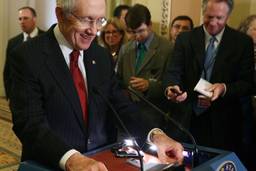Last Friday, December 3, the U.S. Department of Labor announced that the unemployment rate had risen once again. A full three years after the current recession began in December 2007 there is no end in sight as to when the jobs markets will recover. This is in stark contrast to the full recovery of corporate profits and bankers bonuses, now back roughly to where they were in 2006-07, according to U.S. government data.
Banks now have a hoard of cash reserves of more than a trillion dollars, according to the business press. However, as U.S. Federal Reserve Bank data show, as the biggest 19 U.S. banks recovered in 2009-2010, their lending to small and medium businesses declined steadily. Nor has that lending recovered in 2010. Without bank lending to small businesses — the main engine of job creation in the U.S. — there can be no job creation.
Similarly the largest companies, the S&P 500 non-bank corporations, are also sitting on a hoard of cash. At last estimates, an amount of $1.84 trillion in liquid assets, according to the Financial Times business daily.
So with all that cash, why aren’t banks lending and big companies investing and creating jobs, one might ask?
The even more important question is: if banks and businesses have that record hoard of cash on hand why should their taxes be cut, in effect increasing even more that hoard of cash that isn’t being invested? Won’t they just continue to hoard the tax cut too?
The idea that cutting business and wealthy investors’ taxes originated in 1961 with then President John F. Kennedy. But at that time business investment tax cuts were tied to proven job creation. Businesses had to prove they added jobs before they could claim the tax cut. That was changed with Reagan. Now businesses could get the tax credits even if they didn’t create jobs. Their taxes were cut even if it meant they reduced jobs. By the time of George W. Bush, businesses could claim tax cuts for investments made offshore. GM cut hundreds of thousands of jobs in the U.S. while adding thousands in China. Ford cut jobs while adding them in St. Petersburg, Russia. Corporations could claim the investment tax cuts, even if jobs were created offshore and simultaneously eliminated in the U.S. In effect, U.S. taxpayers were paying US corporations to send their jobs overseas.
Between 2001-2004 George W. Bush pushed through a series of annual tax cuts for investors and corporations that amounted to a total of $3.4 trillion over the recent decade, according to the Center on Budget and Policy Priorities. Every tax cut bill passed between 2001-2004 was called a jobs creation bill. More than 80% of the $3.4 trillion eventually accrued to the wealthiest 20% of households and corporations, and most of that to the top 0.1%, or 100,000 households, and the S&P’s largest companies. And what did George W. Bush’s business-investor tax cut produce in terms of jobs? The period 2001-2004 witnessed the weakest jobs creation on record following a recession. It took a full 46 months just to recover the level of jobs in the U.S. that existed in January 2001, when the recession began. Estimates today after the current recession are that it will take 7-8 years to recover the lost jobs, if even then.
Another, more recent test of the “business tax cuts create jobs” idea happened in the spring of 2008. Bush and Congress passed a $168 billion stimulus bill as the recession of 2007-2010 began to deepen. About $90 billion of that comprised tax cuts. What jobs did it create? None. The jobs market collapsed in the second half of 2008 at a rate of nearly one million a month for six months, a rate of job loss that roughly paralleled that of 1929-30.
The Obama stimulus bill of 2009 is yet another example of why tax cuts in general, and business-investor tax cuts in particular, do not create jobs. Of Obama’s original $787 billion stimulus passed in February 2009, about half were tax cuts and more than $225 billion were specifically business-investor cuts. Twenty months later we have virtually no net job creation. Private employers have created about 900,000 jobs in 2010, the majority of which are part time or temporary jobs. For its part, the federal government has created no net new jobs since Obama came into office, while State and Local government have laid off hundreds of thousands over the past year and even more cuts are planned for 2011. The U.S. Labor Department’s most conservative estimate of unemployment (called the ‘U-3’ statistic) today is 9.8% and 15.1 million jobless. The Labor Department’s more accurate estimate (called the ‘U-6’ statistic) today is 17.0% and roughly 23 million jobless.
So what did John Q. Taxpayer get for all that tax cutting? Certainly not jobs, but instead a huge deficit bill now coming due. Nonetheless, the debates in Washington now still focus on more tax cuts in 2011. So long as that’s the focus, the U.S. unemployment situation will continue to stagnate or worsen.
Jack Rasmus is the author of Epic Recession: Prelude to Global Depression, published in May 2010 by Pluto Press, Palgrave-Macmillan.







